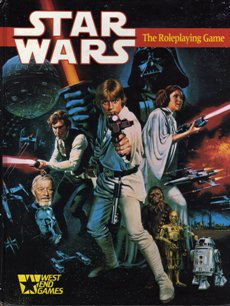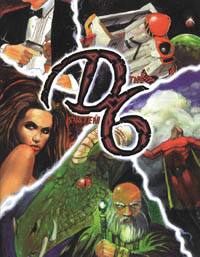West End Games (WEG) was a company that made board, role-playing, and war games. It was founded by Daniel Scott Palter in 1974 in New York City, but later moved to Honesdale, Pennsylvania. Its product lines included Star Wars, Paranoia, Torg, DC Universe, and Junta.

Torg is a cinematic cross-genre tabletop role-playing game created by Greg Gorden and Bill Slavicsek, with art by Daniel Horne. It was first published by West End Games (WEG) in 1990. Game resolution uses a single twenty-sided die, drama cards and a logarithmic results table, which later formed the basis for WEG's 1992 sci-fi RPG Shatterzone and 1994 universal RPG Masterbook. WEG produced over fifty supplements, novels and comics for the first edition. A revised and expanded core rule book was produced in 2005, with a single adventure. After WEG closed in 2010, Torg was sold to Ulisses Spiele, who, after a successful crowdfunding campaign, published a new edition called Torg: Eternity in 2018.
The Bard's Tale is a fantasy role-playing video game franchise created by Michael Cranford and developed by Brian Fargo's Interplay Productions (1985–1992) and inXile Entertainment (2004–present). The initial title of the series was Tales of the Unknown. The Bard's Tale II: The Destiny Knight dropped the Tales of the Unknown series title, as did all ports of the original game after 1988. From then on, the series was known as The Bard's Tale series. Both Cranford and Fargo have refuted the assertion that the original projected titles for the second and third installments were The Archmage's Tale and The Thief's Tale.

Star Wars: The Roleplaying Game is a role-playing game set in the Star Wars universe, written and published by West End Games (WEG) between 1987 and 1999. The game system was slightly modified and rereleased in 2004 as D6 Space, which used a generic space opera setting. An unrelated Star Wars RPG was published by Wizards of the Coast from 2000 to 2010. Since 2012 the official Star Wars role-playing game is another unrelated game, published by Fantasy Flight Games.

The D6 System is a role-playing game system published by West End Games (WEG) and licensees. While the system is primarily intended for pen-and-paper role-playing games, variations of the system have also been used in live action role-playing games and miniature battle games. The system is named after the 6-sided die, which is used in every roll required by the system.

Bill Slavicsek is an American game designer and writer who served as the Director of Roleplaying Design and Development at Wizards of the Coast. He previously worked for West End Games and TSR, Inc., and designed products for Dungeons & Dragons, Star Wars, Alternity, Torg, Paranoia and Ghostbusters.

Masterbook is a generic role-playing game that was published by West End Games (WEG) in 1994.

D6 Fantasy is a generic fantasy role-playing game (RPG) based on the D6 System. D6 Fantasy is published as a stand-alone rulebook and is supported by its own line of supplements.

The Primal Order, or TPO, is a religion-based fantasy roleplaying game supplement. Of particular note, TPO was the first work published by Wizards of the Coast and its president, Peter Adkison. Through TPO, Wizards of the Coast introduced the "Capsystem" concept, enabling gamemasters to seamlessly integrate TPO and future Capsystem titles into other role-playing games.
Ree Soesbee is an American game designer of collectible card games, role-playing games, and massively multiplayer online role-playing games (MMORPGs), as well as a writer of primarily fantasy novels.

Hidden Kingdom is a role-playing game published by New Rules Inc. in 1985.
Ross Watson is a designer of computer, miniature and role-playing games and a writer in various genres. Watson worked on the Warhammer 40,000 Roleplay line as the Lead Developer for Dark Heresy, was the lead designer for Rogue Trader and Deathwatch, and was part of the design team for Black Crusade. He was the lead developer for both Aaron Allston's Strike Force and Savage Worlds Rifts. His written works include the Accursed and Weird War I settings for Savage Worlds, contributions to the Star Wars: Edge of the Empire RPG, and the video games Darksiders II, Warhammer 40,000: Regicide, and Battlefleet Gothic: Armada. Watson has designed rules and scenarios for miniature game lines, such as Dust Warfare, and he has written for several card games, including Warhammer: Invasion, Empire Engine, and the Lost Legacy series.

Ragnarok and Roll is a role-playing game adventure published by TSR in 1988 for the Marvel Super Heroes role-playing game. The adventure was the second in a trilogy of high-level adventures titled the "Elders of the Universe" series.

Reap the Whirlwind is an adventure published by TSR in 1987 for the Marvel Super Heroes role-playing game. It is the second in a dystopian trilogy called "Future in Flames."

The Living Land is a cross-genre tabletop role-playing supplement, written by Christopher Kubasik, with cover art by Daniel Horne and interior illustrations by Jeff Menges, and published by West End Games in 1990. The first sourcebook published for Torg, detailing the mist-filled jungle and its primitive dinosaur people that had invaded two areas of North America. It received mixed reviews in game periodicals including Games International, White Wolf, and Dragon. A rewritten version was published in 2018 by Ulisses Spiele for Torg Eternity.

The Nile Empire is a supplement published by West End Games in 1990 for the cross-genre role-playing game Torg. A second edition was published for the Torg Eternity RPG in 2020.

Gorgoroth is a supplement published by Iron Crown Enterprises (ICE) in 1990 for the fantasy role-playing game Middle-earth Role Playing (MERP), which is itself based on the works of J.R.R. Tolkien.

The Destiny Map is an adventure published by West End Games in 1990 for the cross-genre role-playing game Torg.

White Eagle is an adventure published by Game Designers' Workshop (GDW) in 1990 for the post-apocalyptic military tabletop role-playing game Twilight: 2000.

Kanawa Land Vehicles, subtitled "Wheels for the Possibility Wars", is a supplement published by West End Games (WEG) in 1992 for the multi-genre role-playing game Torg.

















